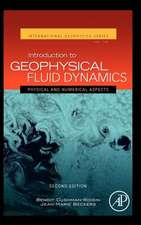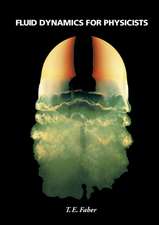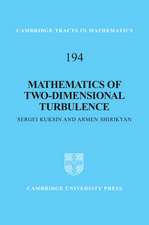The Couette-Taylor Problem: Applied Mathematical Sciences, cartea 102
Autor Pascal Chossat, Gerard Ioossen Limba Engleză Hardback – 11 mar 1994
| Toate formatele și edițiile | Preț | Express |
|---|---|---|
| Paperback (1) | 694.55 lei 6-8 săpt. | |
| Springer – 26 sep 2011 | 694.55 lei 6-8 săpt. | |
| Hardback (1) | 643.48 lei 6-8 săpt. | |
| Springer – 11 mar 1994 | 643.48 lei 6-8 săpt. |
Din seria Applied Mathematical Sciences
- 13%
 Preț: 426.94 lei
Preț: 426.94 lei - 13%
 Preț: 426.46 lei
Preț: 426.46 lei - 13%
 Preț: 427.63 lei
Preț: 427.63 lei - 9%
 Preț: 1728.59 lei
Preț: 1728.59 lei - 24%
 Preț: 906.80 lei
Preț: 906.80 lei - 23%
 Preț: 659.07 lei
Preț: 659.07 lei -
 Preț: 375.65 lei
Preț: 375.65 lei - 18%
 Preț: 909.47 lei
Preț: 909.47 lei - 18%
 Preț: 795.02 lei
Preț: 795.02 lei - 18%
 Preț: 950.52 lei
Preț: 950.52 lei - 15%
 Preț: 645.47 lei
Preț: 645.47 lei - 20%
 Preț: 755.49 lei
Preț: 755.49 lei -
 Preț: 382.67 lei
Preț: 382.67 lei - 24%
 Preț: 808.06 lei
Preț: 808.06 lei -
 Preț: 452.62 lei
Preț: 452.62 lei -
 Preț: 190.23 lei
Preț: 190.23 lei -
 Preț: 399.12 lei
Preț: 399.12 lei - 18%
 Preț: 966.90 lei
Preț: 966.90 lei - 15%
 Preț: 528.80 lei
Preț: 528.80 lei -
 Preț: 413.15 lei
Preț: 413.15 lei -
 Preț: 390.25 lei
Preț: 390.25 lei - 18%
 Preț: 736.01 lei
Preț: 736.01 lei - 18%
 Preț: 1411.05 lei
Preț: 1411.05 lei - 15%
 Preț: 711.21 lei
Preț: 711.21 lei -
 Preț: 395.47 lei
Preț: 395.47 lei - 18%
 Preț: 1017.26 lei
Preț: 1017.26 lei -
 Preț: 403.15 lei
Preț: 403.15 lei - 18%
 Preț: 1130.14 lei
Preț: 1130.14 lei - 18%
 Preț: 1134.87 lei
Preț: 1134.87 lei - 18%
 Preț: 1329.00 lei
Preț: 1329.00 lei - 18%
 Preț: 1129.65 lei
Preț: 1129.65 lei - 18%
 Preț: 1140.71 lei
Preț: 1140.71 lei
Preț: 643.48 lei
Preț vechi: 757.04 lei
-15% Nou
Puncte Express: 965
Preț estimativ în valută:
123.14€ • 133.72$ • 103.44£
123.14€ • 133.72$ • 103.44£
Carte tipărită la comandă
Livrare economică 22 aprilie-06 mai
Preluare comenzi: 021 569.72.76
Specificații
ISBN-13: 9780387941547
ISBN-10: 0387941541
Pagini: 252
Ilustrații: X, 234 p.
Dimensiuni: 155 x 235 x 20 mm
Greutate: 0.5 kg
Ediția:1994
Editura: Springer
Colecția Springer
Seria Applied Mathematical Sciences
Locul publicării:New York, NY, United States
ISBN-10: 0387941541
Pagini: 252
Ilustrații: X, 234 p.
Dimensiuni: 155 x 235 x 20 mm
Greutate: 0.5 kg
Ediția:1994
Editura: Springer
Colecția Springer
Seria Applied Mathematical Sciences
Locul publicării:New York, NY, United States
Public țintă
ResearchCuprins
I Introduction.- I.1 A paradigm.- I.2 Experimental results.- I.3 Modeling for theoretical analysis.- I.4 Arrangements of topics in the text.- II Statement of the Problem and Basic Tools.- II.1 Nondimensionalization, parameters.- II.2 Functional frame and basic properties.- II.3 Linear stability analysis.- II.4 Center Manifold Theorem.- III Taylor Vortices, Spirals and Ribbons.- III.1 Taylor vortex flow.- III.2 Spirals and ribbons.- III.3 Higher codimension bifurcations.- IV Mode Interactions.- IV.1 Interaction between an axisymmetric and a nonaxisymmetric mode.- IV.2 Interaction between two nonaxisymmetric modes.- V Imperfections on Primary Bifurcations.- V.1 General setting when the geometry of boundaries is perturbed.- V.2 Eccentric cylinders.- V.3 Little additional flux.- V.4 Periodic modulation of the shape of cylinders in the axial direction.- V.5 Time-periodic perturbation.- VI Bifurcation from Group Orbits of Solutions.- VI.1 Center manifold for group orbits.- VI.2 Bifurcation from the Taylor vortex flow.- VI.3 Bifurcation from the spirals.- VI.4 Bifurcation from ribbons.- VI.5 Bifurcation from wavy vortices, modulated wavy vortices.- VI.6 Codimension-two bifurcations from Taylor vortex flow.- VII Large-scale EfTects.- VII. 1 Steady solutions in an infinite cylinder.- VII.2 Time-periodic solutions in an infinite cylinder.- VII.3 Ginzburg-Landau equation.- VIII Small Gap Approximation.- VIII.1 Introduction.- VIII.2 Choice of scales and limiting system.- VIII.3 Linear stability analysis.- VIII.4 Ginzburg-Landau equations.

















